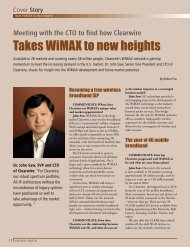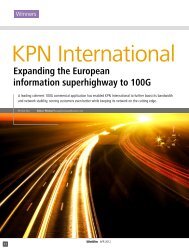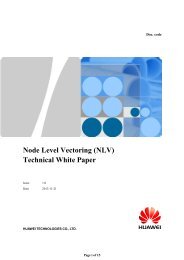Telekom Malaysia - Huawei
Telekom Malaysia - Huawei
Telekom Malaysia - Huawei
You also want an ePaper? Increase the reach of your titles
YUMPU automatically turns print PDFs into web optimized ePapers that Google loves.
operation information platform. Its ecosystem covers ITS,<br />
logistics, cargo/passenger transport, hazmat transport, vehicle<br />
repair/fitting, vehicle manufacturing, vehicle dealership,<br />
vehicle supervision, insurance, emergency rescue, and<br />
mobile Internet, making it a nexus for a variety of copious<br />
data sources. Cloud-based functions such as virtualization,<br />
authentication, real-time interaction, and mass storage are<br />
therefore required. Its application systems also integrate<br />
vehicle data gathering, computing, scheduling, monitoring/<br />
control, management, and applications.<br />
It is noteworthy that the current GPS+GPRS system is<br />
neither true IoV nor IoT; it is only a combined application<br />
of existing technologies. Nonetheless, many ITS tests are<br />
being implemented based on this technology. It would be<br />
unfavorable for any country’s strategic priorities and technical<br />
innovations if IoV development is based simply on this<br />
technology.<br />
What is GID?<br />
A vehicular global ID (GID) terminal is at the core of<br />
the IoV. It is a communications gateway and integrated<br />
or mounted terminal with global ubiquitous network<br />
connectivity. It is also an intelligent in-vehicle sensor with<br />
global positioning and global online identification (online<br />
license plate) functionality. A GID integrates a vehicle’s smart<br />
information sensor, networking, and online license plate, as<br />
shown in Fig. 1.<br />
Vehicular status perception – The GID features various<br />
embedded sensors and connects with a vehicular bus, such as<br />
onboard diagnostics (OBD) or the controller–area network<br />
(CAN), enabling it to perceive and monitor almost all static<br />
and dynamic vehicular information, including environmental<br />
and status-diagnosis information.<br />
Ubiquitous communication – The GID features V2V,<br />
V2I, and ad-hoc network communications; intra-vehicle<br />
networking; inter-format bridging and relay; and global<br />
communication/positioning/roaming capabilities.<br />
Online license plate – The GID determines the status of<br />
vehicles, networks and users to generate an “online ID” for<br />
a vehicle, which is a trusted ID in cyberspace rather than a<br />
mere tag.<br />
Simply put, the GID addresses problems with traditional<br />
radio frequency identification (RFID) that include its<br />
one-way nature, limited range & coverage, lack of speed,<br />
passive and unintelligent operation, lack of perception and<br />
communication, high cost, lack of standardization, and its<br />
ease of loss or damage. The GID also features the V2V, V2I,<br />
and global roaming/coverage required for the IoV, making it<br />
more than a mere telematics instrument. More importantly,<br />
GID provides vehicles with “cyber license plates” or “cyber<br />
IDs,” thereby solving the most difficult problem with IoT<br />
– the fact that an address cannot be separated from its<br />
network ID. GID brings greater online visibility by uniquely<br />
distinguishing all vehicles worldwide. In addition, by working<br />
with the back-end cloud system, GID submits vehicle and<br />
driving status, and even in-vehicle black-box information, at<br />
any time.<br />
Dynamic, multi-source data obtained from the GID can be<br />
utilized for IoV, machine movement, ITS, and cloud computing.<br />
DEC 2011<br />
24

















